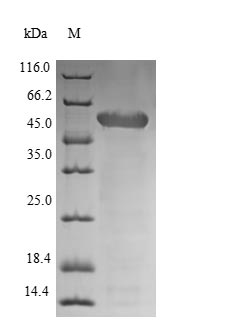This recombinant Staphylococcus aureus Autolysin (lytA) is produced in an E.coli expression system and contains the complete protein region spanning amino acids 1 to 481. The protein carries an N-terminal 6xHis-tag, which makes purification and detection more straightforward. SDS-PAGE analysis indicates a purity level greater than 90%, suggesting it should perform reliably in most research applications.
Staphylococcus aureus Autolysin plays an important role in breaking down bacterial cell walls, particularly during cell division and autolysis. Scientists studying autolysins like lytA hope to better understand how they function in bacterial physiology and disease development. There's also growing interest in how these proteins might contribute to antibiotic resistance and help bacteria survive hostile conditions. This knowledge could prove valuable when developing new treatments for bacterial infections.
Potential Applications
Note: The applications listed below are based on what we know about this protein's biological functions, published research, and experience from experts in the field. However, we haven't fully tested all of these applications ourselves yet. We'd recommend running some preliminary tests first to make sure they work for your specific research goals.
Based on the provided information, the recombinant Staphylococcus aureus Autolysin is expressed in E. coli, a prokaryotic system that is generally suitable for expressing bacterial proteins. Since autolysin is a native bacterial enzyme, the E. coli expression environment has a reasonable probability of supporting its correct folding, as it likely shares similar requirements for disulfide bond formation and lacks complex eukaryotic post-translational modifications. The expression of the full-length protein (1-481aa) further increases the likelihood of proper folding. However, the protein's activity is unknown and unvalidated. The presence of an N-terminal 6xHis tag could potentially, though not necessarily, influence folding or function. Therefore, while the probability of correct folding is reasonably high, it cannot be guaranteed without experimental confirmation of enzymatic activity (e.g., lytic activity against S. aureus cell walls).
1. Protein-Protein Interaction Studies Using His-Tag Affinity Purification
The N-terminal 6xHis tag facilitates purification and immobilization for pull-down assays. However, this application is critically dependent on correct protein folding. If the autolysin is misfolded, its ability to interact with true biological partners from bacterial cell extracts will be compromised, leading to the identification of non-physiological interactions or false negatives. Folding and activity should be validated prior to such studies.
2. Antibody Development and Immunoassay Applications
This application is generally suitable. The recombinant autolysin can effectively serve as an immunogen for generating antibodies. Even if the protein is not in its perfect native conformation, it can elicit antibodies that recognize linear epitopes, which are useful for techniques like Western blotting. The high purity is adequate for immunization. However, it should be noted that antibodies generated against a potentially misfolded protein might not recognize the native, functionally active autolysin in its physiological context. The protein is an excellent positive control for Western blots, as this technique uses denatured proteins.
3. Biochemical Characterization and Substrate Binding Studies
This application is not only appropriate but should be considered a prerequisite for functional studies. The described experiments (pH optimum, thermal stability, binding to peptidoglycan) are the very methods used to determine the protein's folded state and bioactivity. The His-tag is beneficial for immobilization in binding assays like SPR. If the protein shows the expected enzymatic or binding activity, it confirms correct folding. If inactive, these studies will characterize an inactive product.
4. Comparative Protein Structure and Function Analysis
This application is appropriate for structural analysis. Techniques like size exclusion chromatography and dynamic light scattering can directly assess the protein's oligomeric state and folding in solution. Comparative studies with other autolysins can be informative even if the protein is misfolded, as it would highlight differences in stability or behavior. Proteolysis mapping can identify stable domains. This application is valuable for characterizing the recombinant product itself, regardless of its native activity.
Final Recommendation & Action Plan
The recommended course of action is to prioritize biochemical characterization (Application #3) to definitively assess the protein's folding and bioactivity before proceeding to more complex functional studies. This should include enzymatic activity assays using S. aureus cell walls or synthetic substrates to confirm lytic function, and biophysical analysis (e.g., SEC, DLS) to check for proper oligomerization and solubility. If the protein is active and correctly folded, it can be reliably used for interaction studies (#1) and as a standard for native-conformation antibodies. If it is inactive, focus should shift to applications that are less conformation-dependent, such as linear-epitope antibody production (#2) and comparative structural analysis (#4). Validation against a native autolysin preparation is always advised for critical biological conclusions.






